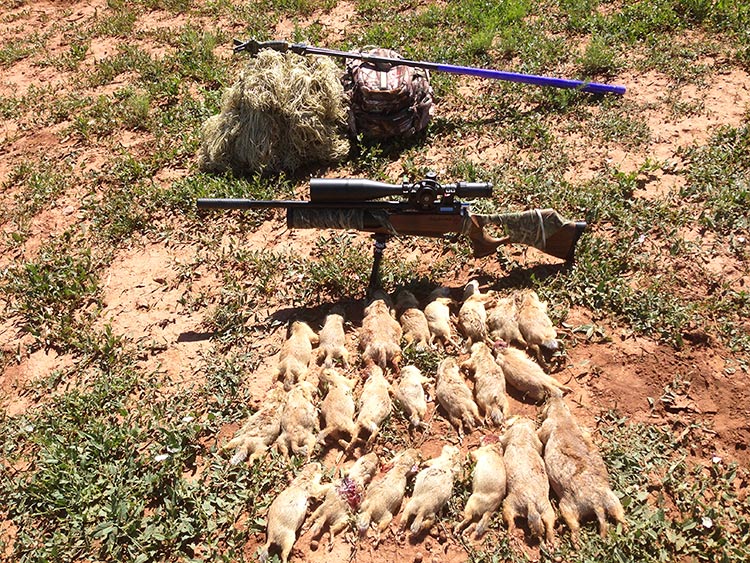
Posted on 10/25/2017 2:46:04 PM PDT by SandRat
SONOITA – In the shadow of the foothills of the Whetstone Mountains, Kurt Licence, a birds and mammals biologist with the Arizona Game and Fish Department, reached his hands into a metal cage and firmly grabbed ahold of a black-tailed prairie dog in front of a small yet electrified crowd.
“Welcome home,” he said, as he carried the animal to another enclosure and prepared to push it down a plastic tube leading to its new home. “You ready?”
The animal was the first of 94 black-tailed prairie dogs released in the Sands Ranch area east of Sonoita on Oct. 13 in the hope that they will help revive the native prairie dog population, which was last documented in Arizona in the 1960s.
AZGFD has been working to reestablish black-tailed prairie dogs in the region since 2008, when biologists first translocated the animals to the Las Cienegas National Conservation Area. This release on a ranch a few miles to the east of Las Cienegas was the first since 2010 and the first done outside the conservation area, said AZGFD spokesman Mark Hart.
Prior to the first release, Licence addressed the roughly 20 people in attendance, mostly comprised of biologists and staff with AZGFD and Pima County, who looked on excitedly as he explained the relocation process.
“(It’s a) really big day for us, big day for these guys and a big day for black-tailed prairie dogs in Arizona,” Licence said. “What I’m going to do is reach in, they’re going to squirm a lot, they really don’t like to be held. There may be some biting involved, but you guys will get a good view of that and hopefully I don’t bleed too much.”
New home
With the help of partners in New Mexico, Licence said, AZGFD biologists captured the prairie dogs in Otero Mesa on Fort Bliss and transported them overnight to the release area.
“We only trap for four days, so they haven’t been in there any more than four days,” he said, pointing to the holding cages. “And we waited for nightfall last night, put them in these covered trucks with the covers down, and shipped them in the cool of the night.”
In the morning, Licence said, the animals were relocated from the holding cages into acclimation cages that have a black tube leading to an artificial nest chamber six feet underground.
Twenty-five artificial burrows were installed on the 40-acre site, which Licence said was chosen because of the rich soil, vegetation and slope of the ground. Though the prairie dogs will be fed and provided water while in the acclimation cages, long grasses on the site will eventually serve as the animals’ food and water source.
He said once they’re accustomed to their new home, the prairie dogs will expand the nest chamber, creating “interlinking networks of tunnels.” The cages surrounding the burrow entries, which protect the animals from predators and prevent them from leaving the area prematurely, will be removed after two weeks.
While AZGFD identified the Sands Ranch area and set up burrows years ago, securing a source population proved to be difficult. License said staff had identified a group in Mexico, but after conducting a genetic study, it was determined the species were too genetically different.
“Unfortunately, black-tails across the U.S. aren’t doing so great, populations are shrinking, so people aren’t willing to give up the prairie dogs they have,” he said. “It took us a little bit to find that source population. But now that we found it, this year we were able to follow through and make this happen.”
Keystone species
Known as a “keystone species,” prairie dogs have a vast effect on the entire ecosystem around them because they clip the vegetation allowing native grasses to grow, recycle nutrients, and their digging activity provides habitats for many other animals, License said.
Licence said biologists hope the project is as successful as it has been in the Las Cienegas area, where he estimated the current population as between 200 and 300 prairie dogs.
Asked if the two populations could meet, Licence said it’s unlikely given the roughly 10-mile distance between Sands Ranch and Las Cienegas.
“Hopefully in time they’ll get big enough to get that close, but as it is now, it’s not likely,” he said. “The maximum dispersal distance for these guys is about five, six max miles, so they’re still a good distance from that.”
In a news release, AZGFD said the first phase of reintroduction can take months and the prairie dogs are regularly monitored during this time.
I like the Firing Line in Manchester. I don’t think we have prairie dogs in New England, so no good place to shoot those.


Mine is a Savage with a yard of scope.
Unfortunately the area already has a very healthy coyote population.
This is so Not a good idea.
I believe that the federal government hates ranchers.
Sonoita. Is the Steak-Out still open?
I’ve had no love for prairie dogs since the first time I drove onto Ft. Hunter-Liggett. There were signs posted along the roadway prohibiting foot traffic on account of “plague threat.” I asked on post and they said it was because the fleas on prairie dogs were plague carriers.
Well alrighty then, pass the .22-250 and let’s go bust some barking ground skwerls.
I first misread it as “cutting back the population” - was going to recommend .22 Hornet....
Caption: Well, can’t talk now. I’m off to work, honey. *smooch*
Disclaimer: Opinions posted on Free Republic are those of the individual posters and do not necessarily represent the opinion of Free Republic or its management. All materials posted herein are protected by copyright law and the exemption for fair use of copyrighted works.